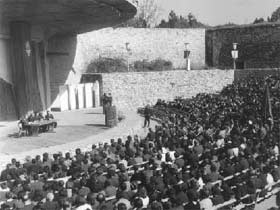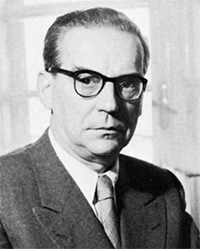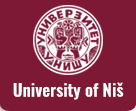
Everything began on June 15, 1965, when the history of the University of Niš started.
The youngest University in the country was founded on that date - third Serbian and seventh Yugoslavian. Since then, the city of Niš has been writing a new page of its history as a University city – exactly five decades of academic development, half a century of university mission passed since then…
More precisely, it all started five years earlier, in 1960. During that year, the first faculties were founded in Niš, the three faculties under the academic patronage of the University of Belgrade, by which the first seeds of higher education in this part of Serbia were sown. The soil in the ancient city on the river of Nišava, then the modern economic and cultural seat and also an important Yugoslav center, was fertile, the seeds received easily, developed and left deep roots. In the years of strong industrial development of the country and the overall economic and social momentum, a young, newly established institution added to its stormy, ambitious reality a new zest, miraculous enthusiasm and academic dream of young generations…
The University of Niš foundation, undoubtedly, represents one of the most significant moments in the contemporary history of the city. By developing itself, the University was at the same time making a new image of the city of Niš, this part of Serbia, and the whole Yugoslavia. In extremely turbulent decades of development, dynamic changes in social relations, and even more in the sphere of technical and technological processes, the higher education staff was the necessity, the outcome and the significant factor of the total changes in the country.
The University, in the years after the foundation, made big contribution to improving the former socialist self-governing community, and it went through different stages of development in the forthcoming decades. It followed the fate of the society from which it emerged, led a number of changes and carried out numerous reforms, instigated and defined development processes through educational, scientific, artistic, professional and human contribution. Today, the highest academic institution in Niš is firmly rooted, stable and mature, with a half-century tradition, and represents the temple of science and art, knowledge transfer and scientific thought. Its driving force is striving towards expanding horizons, progress and development of the overall potential for the benefit of the whole society and individuals in it.
By its elite role, which has by the nature of the academic structure already been assigned to it, the University of Niš represents the most precious connection with the world – with the global science, unique educational space of Europe or the global art trends and developments. The University represents a connection with young generations, academics around the world, who are the future and the new energy of each society. Students guided by youthful ambitions, visions and ideals and professors who possess significant knowledge, experience and who work patiently, give the University a strong driving force and creative power.
The words, with which Prof. Dr. Branimir Janković, the first rector of the University of Niš, ended his first address at the opening ceremony of this higher education institution, were confirmed throughout the latter decades, i.e. throughout a half a century of its academic activities: “University of Niš is a huge historical event for all of us here, for our region and for our Republic of Serbia. It will broadly develop its technical, scientific, social, educational and cultural activities and contribute to faster revival of this region, the Socialist Republic of Serbia and our Yugoslav socialist community.”
University development
15.6.1965 - Foundation of the University of Nis.
1967 - Foundation of the University Librabry "Nikola Tesla"
1968 - The Department of Electronics grew into the Faculty of Electronic Engineering;
1970 - The two departments of the Faculty of Law and Economics became independent faculties; Publication of the first three books of the University proffesors.
1971 - The Departments of Mechanical and Civil Engineering became separate, independent faculties. In the same year, the Faculty of Philosophy was established with its seven departments: Mathematics, Physics, Chemistry, Sociology, Psychology, English and Physical Education;
1972 - The Faculty of Occupational Safety grew out of the Faculty of Civil Engineering;
1977 - Launching of the first University scientific journal "Marxist Themes", which is today published under the title "Themes"
1979 - The Faculty of Technology was founded;
1984 - Establishment of the scientific journal "Facta Universitatis" that has been published ever since (14 independent series in various scientific fields)
1986 - Foundation of JUNIS (The University of Nis Information System)
1987 - The Faculty of Philosophy grew to include the Department of Serbian Language and Literature;
1991 - Formation of the Research Centre of the Serbian Academy of Arts and Sciences (SASA) and the University of Nis
1993 - The Teacher-Training Faculty in Vranje enrolled its first generation of students;
1995 - The Faculty of Civil Engineering expended its academic mission to include a new department - of Architecture, which was consequently added to its name;
1998 - The academic structure of the Faculty of Philosophy widened to include the Department of History. In the same year, the Faculty of Fine Art and the Faculty of Applied Art and Design of the Belgrade University of Art opened their academic divisions in Niš;
1999 - The Faculty of Science and Mathematics and the Faculty of Physical Culture grew out of the Faculty of Philosophy;
2000 - The University family became richer for six new departments: Geography and Biology with Ecology (adjoined to the Faculty of Science and Mathematics), Philosophy, Pedagogy, Slavic & Balkan Studies and Fine Arts (attached to the Faculty of Philosophy).
2002 - The Faculty of Fine Arts was established with three study options - for visual arts, applied arts and music - previously functioning within the Department of Fine Arts of the Faculty of Philosophy.
2004 - New department was formed at the Faculty of Philosophy: Department for Journalism.
2005 - European Credit Transfer System (ECST) was introduced
2007 - Forming the first convocation of the Student Parliament
2008 - The Department of Serbian Language and Literature of the Faculty of Philosophy was divided into the Department of Serbian Language and Department of Serbian and Comparative Literature.
2009 - First Accreditation of the University
2010 - The "Alumni" of the University of Nis was formed as a separate organizational unit
2011 - Multidisciplinary Studies were organized at the University of Nis
2014 - The European Commission awarder the University of Nis with the logo Human Resources Excellence in Research presented at a ceremony in Brussels
By its constant development, the University of Niš has been confirming visionary words of our Nobel Prize-winner Ivo Andrić, echoing from the Opening Ceremony held on October 15, 1965:
" ... As a literary man I would like to say a few words about the importance of literature, and generally, of art, in the life of any nation and individual, including your own. I wish you … not to labor under an old Philistine delusion that the so-called practical man should be bent on "subsistence", that is on things that are considered, allegedly, the only real, turning its back on art and fine artistry as luxury or waste of time, as something accessory, superfluous and surreal.
... As a literary man I would like to say a few words about the importance of literature, and generally, of art, in the life of any nation and individual, including your own. I wish you … not to labor under an old Philistine delusion that the so-called practical man should be bent on "subsistence", that is on things that are considered, allegedly, the only real, turning its back on art and fine artistry as luxury or waste of time, as something accessory, superfluous and surreal.
No one should ever believe that. Art is, quite the contrary, the very quintessence of all forms of our real life, helping us to comprehend life more easily and live it more effectively, to make it at least more bearable to ourselves and to others. It is an indispensable element in the growth of the human spirit, in the development of the higher forms of social life, and it would be unwise and dangerous to deprive ourselves of its help. This applies to any place and any time. And the man belonging to our present society needs it more than it was the case with the previous generations, as the goals of the new life urge him to be a more harmonious and more universal personality, rather than a biased and narrow-minded professional. And it is exactly this harmony between the reason and the imagination, this balance between the goals and the responsibility of practical life on one hand and the width and serenity of the spirit on the other that should give our man a distinctive feature and ability to fully develop all his creative powers..."


